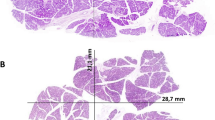Summary
Immunohistochemical distribution of carbonic anhydrase isoenzyme I and II was studied in mixed tumours of major salivary glands and skin. The normal salivary glands displayed strong carbonic anhydrase activity in both ductal epithelium and serous acinar cells and the serous demilune cells in the submandibular glands, including the eccrine ducts. Pleomorphic adenoma salivary gland origin exhibited positive staining in the innerlayer of epithelial cells of tubular, duct-like and glandular structures. No enzymatic staining was noted in the outer layer of tumour cells in these structures. Spindle tumour cells or the fibroblast-like cells with long cytoplasmic processes identified in the adjacent hyalin and myxomatous stroma were rarely positive, while chondroidal and osteo-chondroidal cells were highly reactive. Mixed tumours of eccrine gland origin showed the most reactive staining cells scattered throughout neoplastic epithelium in all tissues examined. Immunohistochemical stainability was usually higher for carbonic anhydrase II than I for both normal and tumour tissues. The biological roles of the distribution profiles of carbonic anhydrase are discussed.
Similar content being viewed by others
References
Barka T (1980) Biologically active polypeptides in submandibular gland. J Histochem Cytochem 28:836–859
Briggman JV, Tashian RE, Spicer SS (1983) Immunohistochemical localization of carbonic anhydrase I and II in eccrine sweat glands from control subjects and patients with cystic fibrosis. Am J Physiol 112:250–257
Carter MJ (1972) Carbonic anhydrase; isoenzymes, properties distribution, and functional significances. Biol Rev 47:465–513
Gay CV, Faleski EJ, Schraer H, Schraer R (1974) Localization of carbonic anhydrase in avian gastric mucosa, shell gland and bone by immunohistochemistry, J Histochem Cytochem 22:819–825
Gresik EW, Barka T (1977) Immunohistochemical localization of epidermal growth factor in mouse submandibular gland. J Histochem Cytochem 25:1027–1035
Hennigar RA, Schulte BA, Spicer SS (1983) Immunolocalization of carbonic anhydrase isoenzymes in rat and mouse salivary and exorbital lacrimal glands. Anat Rec 207:605–614
Kumpulainen T (1981) Human carbonic anhydrase isoenzymes C. Effect of some fixatives on the antigenicity and improvements in the method of localization. Histochemistry 72:425–431
Kumpulainen T, Vaananen KH (1982) Immunohistochemical demonstration of extracellular carbonic anhydrase in epiphyseal growth cartilage. Calcif Tissue Int 34:428–430
Montaguna W, Chase HB, Lobitz WC (1953) Histology and cytochemistry of human skin: IV The eccrine sweat glands. J Invest Dermatol 20:415–423
Mori M, Hamada K, Naito R, Tsukitani K, Asano K (1983) Immunohistochemical localization of epidermal growth factor in rodent submandibular glands. Acta Histochem Cytochem 16:536–548
Naito R, Takai Y, Tsukitani K, Asano K Mori M (1983) Use of lectins for differential localization of secretory materials of granular convoluted tubules and ducts in the submandibular gland. Acta Histochem Cytochem 16:483–493
Nakazato Y, Ishida T, Takahashi K, Suzuki K (1985) Immunohistochemical distribution of S-100 protein and glial fibrillary acidic protein in normal and neoplastic salivary glands. Virchow Arch [Pathol Anat] 405:299–310
Schulte BA, Spicer SS (1983) Light microscopic detection of sugar residues in glycoconjugates of salivary glands and the pancreas with lectin-horseradish peroxidase conjugates. I. Mouse. Histochem J 15:1217–1238
Schulte BA, Spicer SS (1984) Light microscopic detection of sugar residues in glycoconjugates of salivary glands and the pancreas with lectin-horseradish peroxidase conjugates. II. Rat. Histochem J 16:3–20
Spicer SS, Stoward PJ, Tashian RE (1979) The immunohistolocalization of carbonic anhydrase in rodent tissues. J Histochem Cytochem 27:820–831
Spicer SS, Sens MA, Tashian RE (1982) Immunohistochemical demonstration of carbonic anhydrase in human epithelial cells. J Histochem Cytochem 30:864–873
Takahashi K, Isobe T, Ohtsuki Y, Sonobe H, Takeda I, Akagi T (1984) Immunohistochemical study on the distribution of α andβ subunits of S-100 protein in lumen neoplastic and normal tissues. Virchow Arch [Cell Pathol] 45:385–396
Takai Y, Sumitomo S, Noda Y, Hikosaka N, Mori M (1985) Comparison of effectiveness of different fixatives for keratin distribution in ductal segments of salivary glands. Acta Histochem Cytochem 18:141–148
Yoshimura H, Iwasaki H, Nishikawa T, Matsumoto S (1958) Role of carbonic anhydrase in the bicarbonate excretion from salivary glands and mechanism of ionic excretion. Jpn J Physiol 9:106–123
Author information
Authors and Affiliations
Additional information
This investigation was supported partially from Miyata Research fund
Rights and permissions
About this article
Cite this article
Noda, Y., Takai, Y., Iwai, Y. et al. Immunohistochemical study of carbonic anhydrase in mixed tumours from major salivary glands and skin. Vichows Archiv A Pathol Anat 408, 449–459 (1986). https://doi.org/10.1007/BF00705299
Accepted:
Issue Date:
DOI: https://doi.org/10.1007/BF00705299




